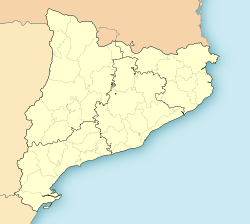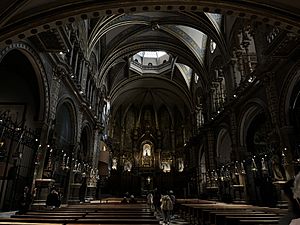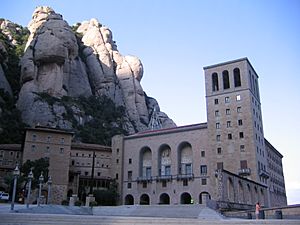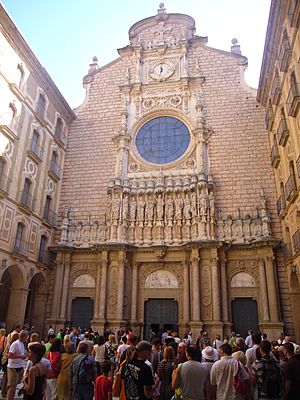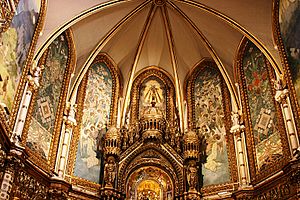Santa Maria de Montserrat Abbey facts for kids
| Monestir de Montserrat | |

Abbey of Montserrat
|
|
| Monastery information | |
|---|---|
| Order | Benedictine |
| Established | 1025 |
| Dedicated to | Virgin of Montserrat |
| Diocese | Sant Feliu de Llobregat |
| Architecture | |
| Heritage designation | Bien de Interés Cultural |
| Site | |
| Location | Montserrat, Monistrol de Montserrat, Catalonia, Spain |
| Coordinates | 41°35′35.54″N 1°50′13.70″E / 41.5932056°N 1.8371389°E |
The Santa Maria de Montserrat Abbey is a special abbey (a home for monks) that belongs to the Order of Saint Benedict. It is found on the amazing Montserrat mountain in Monistrol de Montserrat, Catalonia, Spain. This abbey is famous because it holds a very important statue of the Virgin of Montserrat. The monastery was first started in the year 1025. It was rebuilt a lot between the 1800s and 1900s. Today, about 70 monks live and work there.
Exploring Montserrat Abbey
Where is Montserrat Abbey Located?
The monastery is about 48 kilometers (30 miles) northwest of Barcelona. You can get there by car, train, or even a cool cable car! The abbey has its own train station. This station connects to a special rack railway from Monistrol. There are also two funiculars (cable railways). One goes down to a chapel called Santa Cova. The other goes up to the higher parts of the mountain.
Montserrat mountain is 1,236 meters (4,055 feet) above the valley. It is the highest point in the lowlands of Catalonia. From the monastery, you can walk to Sant Jeroni, the highest peak. On a clear day, you can see almost all of Catalonia. You might even spot the island of Mallorca far away!
What Makes Montserrat Special?
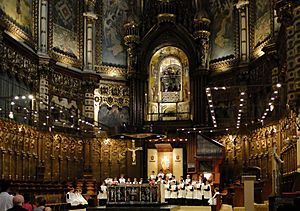
The name Montserrat means 'serrated mountain'. It looks like a saw with jagged peaks. This place is very important for the culture and spirit of Catalonia. Many people come here for quiet reflection. Young people from Barcelona often hike up overnight to watch the sunrise. The Virgin of Montserrat is the patron saint of Catalonia. Her statue is in a special sanctuary next to the Benedictine monastery. The monastery is nestled among the mountain's towers and rocky cliffs.
Around 80 monks usually live at the abbey. The Escolania is Montserrat's Boys’ Choir. It is one of the oldest choirs in Europe. They sing during church services and prayers in the main church.
The main church also has a museum. It displays artworks by many famous painters. The Publicacions de l'Abadia de Montserrat is a publishing house here. It is one of the oldest printing presses still working in the world. Their first book was printed way back in 1499!
Inside the Basilica of Montserrat
Building the main church of Montserrat started in the 1500s. It was completely rebuilt starting in 1811. This happened after it was damaged during a war.
In 1881, Pope Leo XIII gave it the special title of "minor basilica." The first main front of the church was finished in 1901. It was designed by Francisco de Paula del Villar y Carmona. It has detailed sculptures by Venanci and Agapit Vallmitjana i Barbany.
After the Spanish Civil War, a new front for the church was built. This was between 1942 and 1968. Francesc Folguera i Grassi designed it. It has sculptures by Joan Rebull. These sculptures show important religious figures and events.
Before you enter the church, you walk through a large open area. This area has old tombs from the 1500s. There are also sculptures by famous artists like Josep Clarà and Domènec Fita i Molat. The square outside the church has special drawings on the walls. These drawings show the history of Montserrat.
The church itself has one long main hall. It is 68 meters (224 feet) long and 21 meters (70 feet) wide. The ceiling is very high, about 33 meters (109 feet) tall. Large wooden columns support the ceiling. These columns have carvings of prophets like Isaiah and Daniel. At the front is the main altar. It has colorful designs showing scenes from the Bible. A cross from the 1400s, made by Lorenzo Ghiberti, is also on the altar.
Above the main altar is the special room of the Virgin. You enter through a beautiful door made of alabaster. The walls inside have mosaics of saints. Then you reach the Throne Room. This room is decorated with paintings and sculptures. The Virgin's Throne is made of silver. Here, you can see the 12th-century statue of the Virgin. Angels hold her crown and scepter.
Around the main hall, there are several smaller chapels. Each chapel has statues or paintings of different saints. For example, there is a chapel for Saint Peter and another for Ignatius of Loyola. One chapel has a unique image of Christ where only his face, hands, and feet are visible.
The church was updated between 1991 and 1995. In 2015, artist Sean Scully redesigned the Santa Cecilia Chapel next to the abbey.
The Pipe Organ
The church has a pipe organ from 1896. A brand new pipe organ was installed in 2010. It was designed to sound amazing throughout the church. This new organ is a very important piece of musical art in Catalonia.
The Cloister and Garden
The cloister is a covered walkway around a courtyard. It was designed by Josep Puig i Cadafalch in 1929. It has two levels with stone columns. The lower level opens to a garden with a fountain. You can see old stone pieces, some from the 900s, on the cloister walls. The large garden also has a small old chapel and sculptures.
The Refectory
The refectory is the dining hall for the monks. It was built in the 1600s and rebuilt in 1925. The middle of the room has a mosaic of Christ. On the opposite wall, there are pictures showing parts of Saint Benedict's life.
The Montserrat Museum
The monastery has a very important museum with different collections:
- Modern Art: This section has paintings by famous artists from Catalonia like Salvador Dalí and Joan Miró. It also includes works by international artists like Pablo Picasso and French impressionism painters such as Claude Monet and Pierre-Auguste Renoir.
- Ancient History: Here you can see old objects from places like Egypt, Cyprus, and the Holy Land.
- Older Paintings: This part of the museum displays works by artists like El Greco and Caravaggio.
The museum also has collections of Montserrat art and religious items made of gold and silver.
History of Montserrat Abbey
Early Beginnings
Legend says that the statue of the Virgin of Montserrat was found around the year 880. This led to people wanting to honor the 'Moreneta' (little dark one) virgin. Four small chapels were built in the 800s. The exact start of the monastery is not fully known. We do know that around 1011, a monk from another monastery came to Montserrat. He took charge of a small monastery already there. But this small monastery did not like the new arrangement. So, in 1025, a new monastery was founded where an old chapel stood. This new monastery became very important because of the Virgin statue.
Challenges and Rebuilding
In 1811 and 1812, during a war, the abbey was attacked and damaged twice. Many valuable items were lost. In 1835, the abbey was closed for a while. It was reopened and rebuilt starting in 1844.
In 1880, Montserrat celebrated 1000 years since its founding. On September 11, 1881, the Pope Leo XIII declared the Virgin of Montserrat the patron saint of Catalonia.
During Difficult Times
During the Spanish Civil War, the abbey faced tough times. Some monks from Montserrat Abbey were killed. However, authorities tried to protect many religious people. They helped them hide or leave the country.
Later, during the time of Francisco Franco's rule, Santa Maria de Montserrat became a safe place. It was a sanctuary for thinkers, artists, and students. People who were being sought by the authorities often found shelter there.
From the 1940s onwards, Montserrat Abbey became a symbol of Catalan identity. In 1947, a large church service was held. Over 100,000 people attended. During this service, prayers were said in the Catalan language. This was a brave act because the government at the time had rules against using Catalan.
The Abbey of Montserrat also played a big part in publishing books and magazines in Catalan. They helped keep the language and culture alive. The abbey also offered a safe place for people who were working secretly for political change.
In December 1970, about 300 Spanish artists and thinkers held a peaceful protest at the abbey. They were protesting against harsh sentences given to some people. The police surrounded the monastery. But their actions helped convince the government to change the sentences.
Montserrat Today
In 2025, the Monastery of Montserrat will celebrate its 1000th birthday! Many events and celebrations are planned. The motto for these celebrations is Ora lege labora rege te ipsum in communitate. This means "Pray, read, work, rule yourself in community."
Montserrat in Stories
The first part of Dan Brown's 2017 book Origin takes place at Santa Maria de Montserrat. In the story, an important secret meeting happens there.
See also
 In Spanish: Monasterio de Montserrat para niños
In Spanish: Monasterio de Montserrat para niños
- Llibre Vermell de Montserrat
- Saint Jerome in Meditation (Caravaggio)
- Joan Cererols
- A year’s journey through France and Spain, Vol 1, 1777 Philip Thicknesse Letter xx onwards


